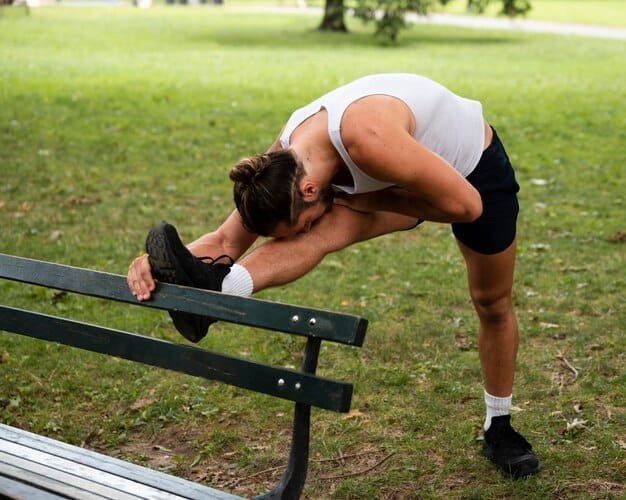The hip thrust is a multi-joint exercise mainly aimed at strengthening and growing the gluteal muscles, but it also works the hamstrings. Usually done with a barbell, it can also be performed with a single dumbbell at moderate weights. You can do the hip thrust with both legs or just one leg, which is particularly useful for those with back pain.
Understanding the Hip Thrust
The hip thrust primarily targets the gluteus maximus, the largest of the gluteal muscles. It’s special because it isolates and engages the gluteus maximus more effectively than many other lower body exercises.
Two main joints are involved in the hip thrust: the hip joint and the knee joint. While the knee joint helps stabilize and support the lower limb, the main action happens at the hip joint.
This exercise is great for bodybuilding and strength sports due to its focus on the posterior chain, which includes the hamstrings, glutes, and lower back. Unlike other exercises like squats or deadlifts, the hip thrust specifically targets the glutes, making it a must-have for improving muscle symmetry, strength, and power in the lower body.
Adding hip thrusts to your routine can boost athletic performance, improve movement efficiency, and lower the risk of injury by strengthening the muscles and ligaments around the hip and knee joints. Plus, you can perform it with different equipment, so it’s accessible for all fitness levels.
How to Perform a Hip Thrust with a Barbell
Performing the hip thrust requires attention to detail. Your starting position is key for proper execution. The movement should end with your knees at a 90-degree angle and your femurs parallel to the floor.
Here’s a step-by-step guide:
1. Find a stable platform, like a bench, to rest your upper back on.
2. Sit on the floor with your legs extended and the platform behind you. Place the barbell on your pelvis, cushioning it with a towel if it’s heavy.
3. To target the gluteus medius more, use an elastic band around your legs and push into abduction during reps.
4. Bend your knees to 90 degrees with your buttocks on the ground and your upper back on the edge of the platform. Your feet should be slightly wider than shoulder-width, and your toes pointed slightly outward. Tilt your chin slightly toward your chest.
5. Before starting, do a few practice reps to ensure your posture and setup are correct.
6. Grab the barbell just outside hip width, holding it firmly to stabilize it.
7. Inhale and start pushing through your heels, exhaling as you go.
8. Raise your pelvis to the maximum height without overextending. For added tension, you can pause at the top.
9. Lower your hips back to the start, controlling the movement and inhaling as you descend.
Benefits of the Hip Thrust
The hip thrust is excellent for building and strengthening the glutes. It’s often more effective than other isolation exercises like cable jumps or machines. Additionally, it can be helpful for those with weak glutes who can’t perform more common multi-joint exercises.
The hip thrust works differently from other exercises by not pre-stretching the glutes and reaching peak tension when the muscles are fully contracted.
Limitations of the Hip Thrust
A major limitation is the misconception that it’s a “female” exercise, causing some male athletes to overlook its benefits. Proper setup is crucial; otherwise, the exercise might be uncomfortable or ineffective. People with recurring low back pain might struggle with the hip thrust and should consider reducing the load or trying the one-leg version.
Common Mistakes to Avoid in the Hip Thrust
– Placing feet too far forward, which overworks the quadriceps.
– Placing feet too far back, which overworks the hamstrings.
– Poor coordination of breathing.
– Using too much weight, making it hard to complete 8-10 reps.
– Not achieving full range of motion, preventing the glutes from fully extending.
– Arching the back to exceed the natural range of hip extension.
In conclusion, the hip thrust is a versatile and effective exercise for strengthening the glutes and hamstrings. Pay close attention to proper execution and avoid common mistakes to get the most out of this exercise. Adjust it to fit your personal needs and abilities to maximize benefits.







